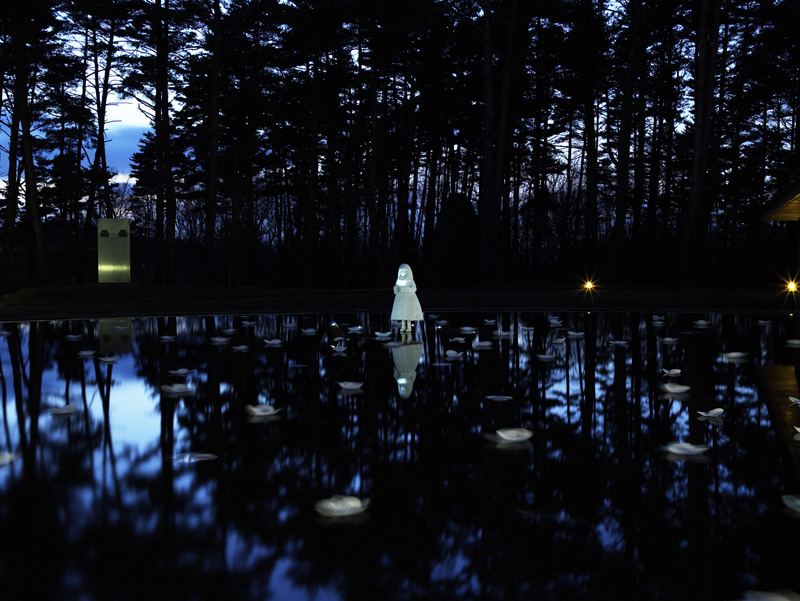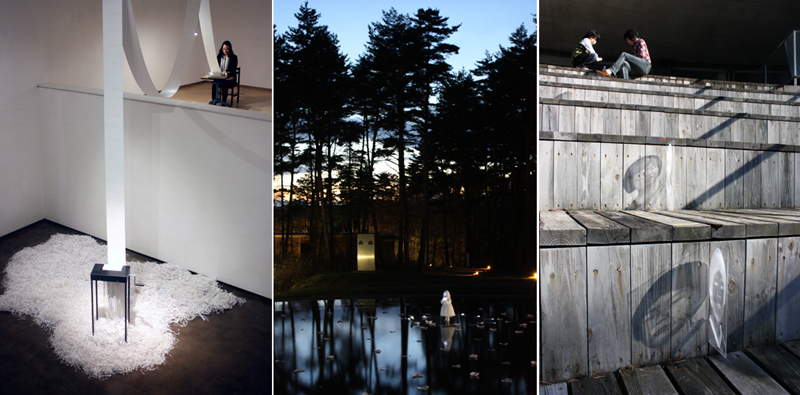
photo by 山本 糾(やまもと・ただす)
Conversation Piece––PARK Hyesoo Communicates through her Work
KONDO yuki (Curator, Aomori Contemporary Art Centre)
For me, "Home" is a space of chaos. Is home a space which eats people's dream? Home is a space which protects people. However at the same time, it is a space where people let themselves stay and locked up and put their dreams on hold. So the first reason why people could not fulfill their dreams is their home.1
PARK Hyesoo has inquired repeatedly about “HOME” in her works (fig. 1). In these works, she uses home, where a family lives together, as a motif to represent “the everyday”, “the nearby environment” and “the minimum unit of interpersonal relationships.” Considering it as an ambiguous entity or an existence with some negative aspects that can be universally shared and emphasized, she deals with such themes as loss, oppression and control through home-related subjects.
In Park’s 2008 exhibition “Locked Room” (Selected Emerging Artists) at the Seoul Museum of Art, motifs related to home recurrently appeared. For example, in the Forgotten, Thus Lost Ones -- series (2008) (fig. 2, 3), depicted on the clear acrylic sheets were photographs of Park and her mother standing before an elementary school gate on her first school day, her previous house, her class, and so on. The acrylic sheets are part of water tanks that contain water. As the light bulbs above shed light, the images on the acrylic sheets cast their blurry shadows on the wall. As the motors installed on the tanks shake the water, the images become even blurrier, evoking the obscurity of old memory. As we accumulate various experiences and new memories, it becomes difficult for us to remember the pleasant experiences of family and the faces and names of old friends as time goes by. The values of these memories are re-appreciated only after we find they are lost, when we acquire a new perspective in a different phase of life. Park often deals with these motifs as if they are absent or lost, and the sense of loss is suggested in this work in a more or less sentimental manner. However, her repetitive use of these motifs seems to lead us to question if there is anything lacking in our daily lives rather than to simply evoke homesickness or nostalgia.
At the exhibition of these works, she conducted a questionnaire with the following four questions about loss:
(1) If you could meet one thing or person you lost in your life again, what or who would that be?
(2) Why did you choose that thing/person?
(3) How did you lose that thing/person?
(4) Do you remember that thing/person well? Can you describe what it/he/she looked like?
About a thousand answers were collected before the exhibition opened and became the material for her exhibition. Park also used the answers in a more direct way in Unasked Question, Unheard Answer (2008) (fig. 4) by typing them on a paper roll and sending them into a shredder in the room across the partition so that they eventually become a heap of scraps. Park still continues to conduct the same questionnaire along with other questions through her website.
These are questions about loss that we seldom think of and ask others. Nevertheless, she asks these questions that require each respondent to look back at his/her personal history and inner self, and then make the act of collecting replies itself her own project or use the answers as materials for her work. She not only conducts a survey of a large number of anonymous people, but also listens to people chatting in places such as cafés, buses or benches in parks. The conversations she hears in these places are mostly non-committal and harmless, simply in order to be nice to each other or to lie to oneself at times, or to enjoy the act of chatting itself. Park discovered one day that these everyday conversations are much the same. Though they certainly lubricate communication, aren’t the speakers valuing the smoothness of conversation rather than the honesty of their words too much because of their desire to avoid conflicts and serious thinking? This tendency is especially conspicuous in the close relationships between parents and children, friends, and teachers and students, all of which sometimes need to have serious and honest discussions, or even arguments. Park considers that the Korean society give priority to what others think but are poor at expressing themselves.
Conducting surveys and creating works of art based on the results––at this point, this communication is not mutual. While appreciating the personal differences and individuality of each respondent, Park only throws questions and uses the answers as materials for her work without analyzing them or responding to them. In turn, the answers used in her works become the questions to the spectators of her exhibition. The artist or the work asks questions that we can seldom ask, as if the exhibition is a place to express these inquiries in public. Probably more important for Park is to collect answers and to give chances to many people to speak out through her work than to analyze and interpret the results of her questionnaires.

Park had intended to have a similar kind of project here at ACAC as well but she didn’t realize it because it would take far more time in a different country with a different language, and it is hard to apply the Korean-grown concept of the project to Japan immediately. Besides, the woodsy environment and the unique architecture of ACAC were more impressive to her than the people in the town, as Park had intended to incorporate the environment into her work. In addition, it is also possible that during her residence, she had renewed her interest to the theme of “HOME,” which is the title of the exhibition. As a result, she dealt with “HOME” from the perspectives of loss and alienation rather than that of communication.
Forget-Me-Not, which was exhibited on the Water Terrace surrounded by the semicircular Exhibition Hall, is based on The Little Match Girl by Hans C. ANDERSEN. Home is an object of eternal aspiration and yearning to those who do not have it while it is ordinary and even troublesome to those who do. The famous story of the match-vending girl who dies dreaming of the warmth of an ordinary family gathering represents this.
The Forest of Missing Children, installed in the Open Stage, is also a work that evokes the ephemerality of ordinary happiness and its value by representing something lost. Faces, which are based on the portraits of missing children picked up from the website of an organization searching for them, are depicted on an acrylic board. These images do not emerge unless the sun shines in from certain angles. And yet, even if the sun shines, they appear only for seconds or minutes and soon get deformed and disappear. This suggests what the parents of the missing children would think––if they can see their loved ones again, if they can accurately remember their faces, if they can identify their grown-up faces, and so on.
Forget-Me-Not, which is composed of a white statue of a girl standing in the Water Terrace all alone as if refusing any color, with a little light in her hands surrounded by white flowers like water-lilies with petals molded with shells, and The Forest of Missing Children, which emphasizes the transience and sorrow of the subject with the portraits of children, as lifelike as photographs, that appear on an acrylic board only for a moment. The stories behind these works are obvious and well-known to us so it is easy to imagine the tragedy behind. Her two beautiful installations at ACAC represent the tragic cases of the loss of “HOME,” her frequent theme, in a simple and straightforward manner.
Meanwhile, this seemingly simple presentation of well-known stories reminds us of the questions about loss that Park has asked many times for her exhibition, “Locked Room.” While those questions and answers are seldom exchanged in our daily conversations, everyone has a story or two about the losses that he/she has experienced. Nobody lives without experiencing major losses when detached from his/her mother at birth and when separated from the world by acquiring language. In other words, loss is thus universal and a hole that is present in everyone’s interior. Thus the query about it is inspiring and stirs our emotion. What loss evokes may form a contrast with what home evokes.
The various questions Park asks are therefore internal and yet have functions as apparatuses for collecting responses. She explained the reason she makes original perfumes for visitors and conducts a psychological exam in her project Ask Your Scent is that they are devices to attract people that are usually indifferent to art to her exhibition and have them see her work.2 The practical purpose of doing these was to gather as many words and many characteristics as possible. As the collected scents are eventually used for her next work, the custom-made perfumes and psychological exam are mere devices to acquire the visitors' scents. Popular stories and tragedies that win public sympathy are accessible. Because such stories are universal, people turn their concern to the tragedy of the stories and then to their own sorrow or family matters.
Park’s use of popular stories about “loss” to delineate the problems and her conducting surveys about “issues about the essence of human life” to promote the respondents to think are basically similar. The statue of the sad-looking girl and the portraits of lovely children attract the public attention with generous accessibility. However, these are different from mere psychological exams or documentaries because these productions are not their goal; rather, they seek to promote the viewers to produce sequels of the stories or create others. They are conversation pieces as family portraits based on the loss of family.
In addition to the art project Ask Your Scent, Park held a workshop entitled “Making Family Clocks Using Photo Images” and heard various stories from the participants. She says she is increasingly concerned with the issues about families. Through her projects and exhibitions at ACAC, she must have added a lot to her collection. They will produce more questions or new works of art in the future.
----------------------------------------------------------------------------------------------------------------------------------------------------------------------
1 PARK Hyesoo, from the statement in the application form to the 2009 Fall Artist in Residence Program, 2008 (written in English). She wrote a similar commentary for her 2008 work, The People’s Home. (2008 SeMA―Hye Soo Park―The Locked Room, Seoul Museum of Art, 2008, p.20.)
2 Park, Lecture at ACAC, November 23, 2009.
(Translated by YAMAKAWA Sumiko)
▶MORE